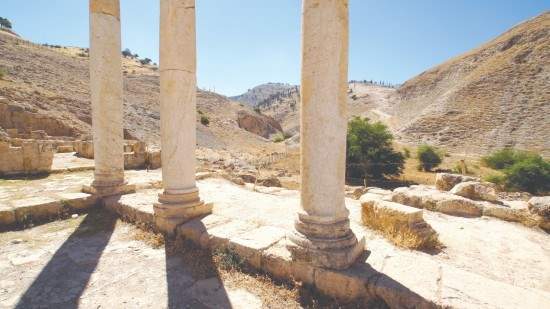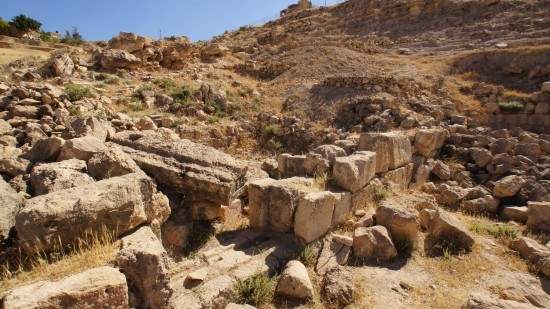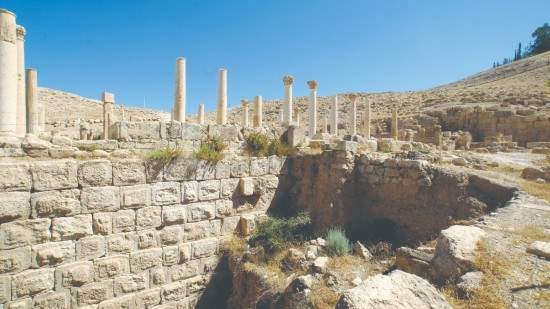AMMAN — Pella, 100km north of Amman, is an ancient city known for hosting one of the earliest Christian communities during the first century AD.
It is also the battlefield of one of the earliest, decisive encounters between Muslims and Byzantines in 635 AD.
اضافة اعلان
As one of the 10 ancient cities situated in the south of the Levant (or the Decapolis), Pella flourished during the
Roman era, but its history of inhabitation dates back to prehistoric ages.
Six of these city-state settlements were in Jordan, three in Syria, and one in Palestine. Jordan had Gerasa (
Jerash), Capitolias (Beit Ras), Gadara (
Umm Qais), Philadelphia (modern day
Amman), Abila, and Pella.
According to historians, the city was named Pella by the Greeks of Alexander the Great, as its original name, Pahel, reminded them of Alexander’s birthplace and capital of Macedon.
 Pella, in northern Jordan, is one of 10 ancient cities situated in the south of the Levant referred to as a Decapolis city, important cities in ancient Rome. (Photos: Flickr)
Pella, in northern Jordan, is one of 10 ancient cities situated in the south of the Levant referred to as a Decapolis city, important cities in ancient Rome. (Photos: Flickr)
As a city in the late Bronze Age (19th century BC), it was referred to as Pihilum in the Egyptian Execration texts, which list the Pharaoh’s enemies and troublesome foreign neighbors.
It was also mentioned in the Egyptian Amarna Letters in the 14th century BC, specifically in a correspondence between Pella’s prince, Mut-Balu, and the Egyptian commissioner, Yanhamu.
During the Ptolemaic control of the town in the 3rd century BC, Pella was named Bernice.
 Pella, in northern Jordan, is one of 10 ancient cities situated in the south of the Levant referred to as a Decapolis city, important cities in ancient Rome. (Photos: Flickr)
Pella, in northern Jordan, is one of 10 ancient cities situated in the south of the Levant referred to as a Decapolis city, important cities in ancient Rome. (Photos: Flickr)
Like all other Decapolis cities, Pella reached its golden age during the Roman era, especially in the first three centuries AD, when it was located on a main trade route that connected Philadelphia (Amman) to Scytholpois (Beisan).
Around 70 AD, a number of Christians fled Jerusalem to Pella to avoid Roman invasion of Jerusalem, according Esuebius, a 4th century historian of Christianity.
Esuebius said, “The people of the Church in Jerusalem were commanded by an oracle given by revelation before the war to those in the city who were worthy of it to depart and dwell in one of the cities of Perea, which they called Pella.”
 Pella, in northern Jordan, is one of 10 ancient cities situated in the south of the Levant referred to as a Decapolis city, important cities in ancient Rome. (Photos: Flickr)
Pella, in northern Jordan, is one of 10 ancient cities situated in the south of the Levant referred to as a Decapolis city, important cities in ancient Rome. (Photos: Flickr)
Excavations at the site unearthed many artifacts and buildings dating back to the Neolithic, bronze, and Iron ages.
Archaeologists found that the Roman city stands on top of storehouses and walls built during Chalcolithic and Bronze Ages 4th and 3rd millennia BC.
The excavations also revealed a temple that dates back to 1270 BC, dedicated to the Canaanite god, Baal.
At the site, buildings from the Roman period date back to 150 AD and include a gate, a theater a nymphaeum (monumental fountain), a temple, and baths.
Three churches, a Bishop’s palace and many houses and shops were dated to the Byzantine era.
 Pella, in northern Jordan, is one of 10 ancient cities situated in the south of the Levant referred to as a Decapolis city, important cities in ancient Rome. (Photos: Flickr)
Pella, in northern Jordan, is one of 10 ancient cities situated in the south of the Levant referred to as a Decapolis city, important cities in ancient Rome. (Photos: Flickr)
During the Muslim era, which started in 635 AD, the city’s name became Tabaqat Fahel, which is still used today.
The churches and other aspects of Christian life continued under the Muslim rule, with the archaeology showing modification to meet evolving social and political environments.
Like other ancient cities in the north of Jordan, Pella was devastated by the massive 749 Galilee earthquake with its multistoried houses collapsing and trapping people and animals below.
 Pella, in northern Jordan, is one of 10 ancient cities situated in the south of the Levant referred to as a Decapolis city, important cities in ancient Rome. (Photos: Flickr)
Pella, in northern Jordan, is one of 10 ancient cities situated in the south of the Levant referred to as a Decapolis city, important cities in ancient Rome. (Photos: Flickr)
However, the earthquake did not end life in Pella as archaeologists found a number of houses and khans (caravanserais) that date back to 8th-10th centuries.
Not much was found in Pella from the Middle Ages, only pottery shards from the Ayybid era (12th century), among other things.
There is a rest house at the site that serves food and beverages and overlooks the archaeological park as well as the Jordan Valley.
Read more Travel








